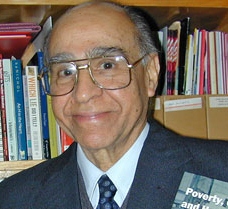Latest Contributions
My Memories of Dr. V. Kurien
Category:

A.H. Somjee received his Ph.D. in Political Science from the London School of Economics. He is a charter member of the Simon Fraser University, Canada, where he is also an Emeritus Professor of Political Science. He has taught at the University of Baroda, the London School of Economics, University of Durham, and the National University of Singapore. He was also appointed as an Associate Fellow at the Queen Elizabeth House, Oxford University, and was invited to Harvard University, several times, as a Visiting Scholar.
When I was a faculty member of the M.S. University of Baroda (now Vadodara), from 1956 to 1964, I had heard the name of Dr. V. Kurien from various colleagues and people in surrounding villages.
The man in charge of AMUL did seem to me to be worth meeting in Anand, which was then a small town, less than 30 miles from Baroda. I worked with my students in surrounding villages, one of which is Boriavi, hardly a few kilometres from Anand, but still I could not meet him, despite my great desire to do so.
In 1964, I left India to teach in Durham University in Britain, and in 1965, I joined Simon Fraser University in Vancouver. In Vancouver, I was very keen to find out how the villages of free India were shaping up. In 1968-69, I got an official opportunity to travel to India. I selected Anand for my study and landed there.
At that time, Anand, despite its delightful name, was still a small place, hardly distinguishable from any other big village in the state of Gujarat. My wife, Geeta Somjee, and I decided to meet Dr. Kurien, the head AMUL diary. At that time, Kurien was in his late forties. He was full of jokes. What was more, he was from the same town in Kerala, as my wife. When they started talking in Malayalam, they discovered that they were neighbours but they had never met in Kerala.
Initially we settled down in a house in front of AMUL dairy, but Kurien insisted that we stay in the guesthouse, specially built for visitors. It was fully air conditioned, with a swimming pool and a kitchen.
Year after year, my wife and I went to Anand from Simon Fraser University. We had selected Anand city for our study and, on the side, we used to look at how AMUL was shaping the district of Kheda, where it is located. The people of Kheda, specially the Patidars (surname Patel), had played a tremendous role in developing Anand, and the neighbouring districts and beyond.
In village after village, in Gujarat, we came across people wanting to improve their standard of living, and asking us how they could go abroad. They got educated and explored how they could improve their standard of living.
To all of them, dairying became the first alternative. They went after it, increased their incomes, and explored other ways to prosper still further.
When the National Dairy Development Board (NDDB) was established in 1965, Kurien's approach did not change. He wanted every district of India to have a milk cooperative similar to that of AMUL dairy. Today, a large number of India's milk cooperatives are affiliated to NDDB.
Shrewdly, he dealt with various chief ministers and established dairy cooperatives. He first of all helped in the establishment of dairy cooperatives in neighbouring districts, and then affiliated them to NDDB. He made India the largest milk producer in the world. India makes two and half billion dollars through milk. And we had the privilege of looking at them in most of the neighbouring states of Gujarat. And what is more, India is at it, building more and more cooperatives in more and more villages.
This effort will go on.
Dr. Kurien, thus, changed the milk picture of India. From vendors of milk, who always cheated by mixing water, he changed the industry itself, which was one of the most difficult things to do. The difficulties he had faced in doing that were phenomenal, but he stuck to his resolve and did it.
In building India's dairy industry, he had a lifetime fight with the bureaucrats of New Delhi. Till the very end, they created hurdles and tried to bring him down, but they did not succeed. He knew how to play the game of beating down the bureaucrats of New Delhi, and practically every other week he was in New Delhi, pleading his case. As greater and greater success came his way, his critics dwindled.
Half a glass of milk, or buttermilk, to an average student in every village was his dream, but he did not live long enough to implement it in all the districts of India.
His last few years were not very happy. The people of Gujarat had matured, and wanted to know what was next after the dairy business. In addition, he had no answer. Curiously enough, living in the west, some of us felt that Gujaratis had moved beyond dairying, but we could never convince Kurien of it.
With the passing away of Dr. Kurien, a great chapter in India's history of building itself, ended.
© A H Somjee 2012
Add new comment